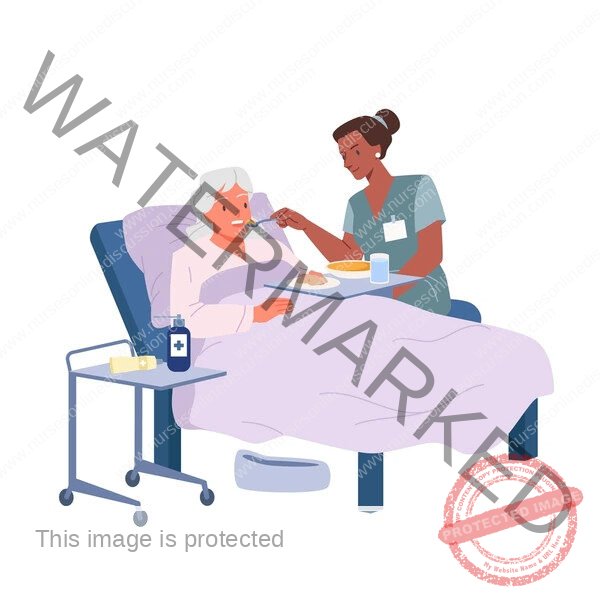Foundations of Nursing I
Subtopic:
Carry out Adequate Feeding of Patients

Role of the Nurse in Patient Feeding
Feeding is not merely about giving food; it’s a therapeutic nursing activity that supports healing, maintains health, and improves a patient’s quality of life. The nurse acts as a caregiver, observer, and educator in the feeding process.
Feeding can be:
Independent (patient feeds self)
Assisted (partial help)
Dependent (full feeding by caregiver)
📋 Nursing Assessment Before Feeding
Prior to feeding a patient, the nurse must assess the readiness and appropriateness of feeding. Key assessment areas include:
1. Level of Consciousness
Is the patient alert or drowsy?
Can they follow instructions?
2. Swallowing Ability
Risk of choking?
Any history of dysphagia (difficulty swallowing)?
3. Type of Diet Ordered
Is the patient on a regular, soft, pureed, or liquid diet?
Any restrictions? (e.g., diabetic, low sodium, fluid restriction)
4. Positioning Needs
Can the patient sit upright unassisted?
Risk of aspiration in supine position?
5. Feeding Route
Oral feeding vs enteral feeding (e.g., via nasogastric tube)
6. Cultural/Religious Considerations
Any dietary beliefs or taboos?
Fasting periods or preference for certain foods?
🍽️ Supplies & Preparation
Before feeding, prepare the environment and tools for a smooth and respectful process.
Materials may include:
Meal tray (as per diet order)
Napkins or bib
Feeding spoon/fork
Towel for protection
Drinking water (unless contraindicated)
Tissue or wipes
Suction apparatus (if risk of choking exists)
Environmental Prep:
Clear distractions and ensure patient privacy
Assist patient to Fowler’s or semi-Fowler’s position
Ensure that oral hygiene is completed before meals
🛠️ Actual Feeding Procedure (Oral Feeding)
Verify the Right Patient and Diet
Use the three checks (name band, verbal confirmation, and diet chart)
Wash Your Hands and Wear Gloves
Always follow infection control procedures
Communicate Clearly
Explain the process to the patient
Encourage slow chewing and swallowing
Begin with Small Quantities
Use a teaspoon and feed small amounts at a time
Watch for signs of discomfort or choking
Offer Fluids Between Bites
Helps in swallowing and digestion
Maintain Conversation (if possible)
Keeps the patient relaxed and makes the process comfortable
Watch for Non-Verbal Cues
Facial expressions, coughing, or restlessness may signal problems
Stop if the Patient Is Tired
Allow rest or stop the session if needed
Clean the Patient After Feeding
Wipe mouth and hands
Help patient rinse mouth if necessary
Document the Feeding
Record type and amount of food taken
Note any difficulties or refusals
🍲 Specialized Feeding Methods
1. Nasogastric Tube (NGT) Feeding
Used when the patient cannot swallow but has a functioning gastrointestinal tract.
Requires checking tube placement and flushing with water before and after feeding.
2. Gastrostomy or Jejunostomy Feeding
Long-term enteral feeding through surgical opening
Sterile technique required during handling
3. Assisted Hand-Over-Hand Feeding
For patients with mild physical disability, nurses guide their hand movements to foster independence
⚠️ Warning Signs to Monitor
While feeding, observe for the following danger signs:
Coughing or choking
Gurgling voice after swallowing
Watery eyes or runny nose (sign of aspiration)
Refusal to eat or sudden fatigue
Blue lips or fingertips (cyanosis)
Vomiting or regurgitation
If these signs appear:
Stop feeding immediately
Suction airway if necessary
Inform senior nurse or physician
Follow emergency protocol for aspiration
🧠 Patient Feeding and Psychology
Feeding is emotionally loaded, especially for patients who have lost independence. Consider the following:
Dignity: Avoid treating adult patients like children.
Privacy: Avoid feeding in open wards unless necessary.
Encouragement: Praise efforts in self-feeding even if minimal.
Respect: Never force feed or rush the patient.
🍛 Diet Types Common in Clinical Practice
| Diet Type | Indication |
|---|---|
| Clear liquid diet | Post-op, GI infections, before diagnostic tests |
| Full liquid diet | Difficulty chewing/swallowing, progressive recovery |
| Pureed diet | Severe chewing/swallowing issues |
| Soft diet | Mild oral issues, elderly patients |
| High-protein diet | Malnourished, healing wounds, burns |
| Diabetic diet | Diabetics – balanced carbs and sugar control |
| Low-sodium diet | Cardiac/kidney patients |
| Bland diet | GI ulcers or inflammation |
Documentation Checklist for Feeding
Include these entries in the patient’s chart or nursing report:
Time of feeding
Type of meal given
Assistance required (full, partial, independent)
Quantity consumed (e.g., 75% of meal)
Patient’s tolerance
Any complications (e.g., gagging, aspiration)
Emotional or behavioral responses (e.g., distress, refusal)
👥 Nurse Collaboration and Delegation
Involve nutritionists/dieticians for special diet planning.
Delegate feeding to trained aides under supervision for non-critical patients.
Coordinate with speech therapists if dysphagia is suspected.
🎯 Key Skills in Adequate Feeding
Observation: Watch patient cues carefully.
Patience: Feeding can take time, especially for the elderly or very ill.
Communication: Keep the patient involved and informed.
Flexibility: Adjust the approach depending on the patient’s physical and emotional state.
Related Topics
• General Principles and Rules of All Nursing Procedures
• Hospital Economy
• Use of Personal Protective Equipment
• Routine and Weekly Cleaning of the Ward
• Waste Management and Disposal
• Isolation of Infectious Patients
• Causes of Infection
• Medical Waste Disposal and Management
• Cleaning Methods
• Carry out Adequate Feeding of Patients
• Perform Bladder and Bowel Care
• Passing a Flatus Tube
• Administration of Enema
• Ward Report
• Lifting/Positioning a Patient
• Tepid Sponging
• General Principles in Patient Care
• Ethics in Nursing Care
• Principles of Infection Prevention and Control
• Body Mechanics
• Bed Making
• Vital Observations
• Bed Bath
• Oral Care/Mouth Care
• Care and Treatment of Pressure Ulcers
Get in Touch
(+256) 790 036 252
(+256) 748 324 644
Info@nursesonlinediscussion.com
Kampala ,Uganda
© 2025 Nurses online discussion. All Rights Reserved Design & Developed by Opensigma.co

